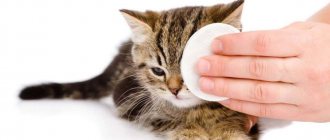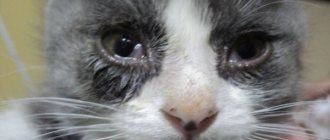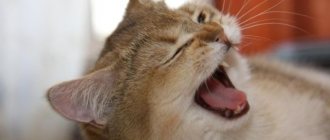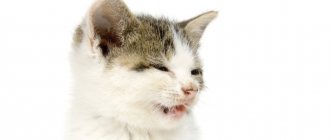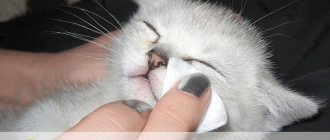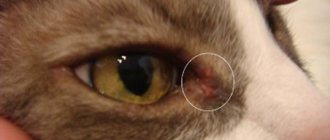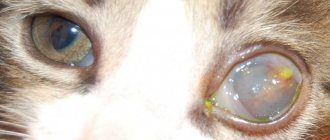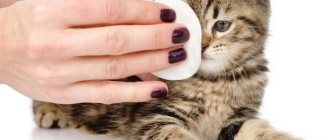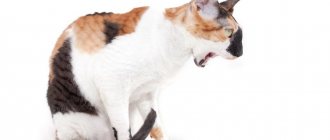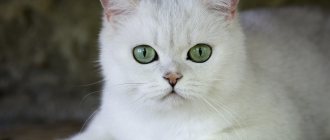Every pet owner suffers when their pet gets sick. The realization that he cannot help himself and regulate his condition on his own is depressing. I would like to help quickly and efficiently, but I don’t always have enough knowledge and experience. It is especially difficult when the cause of the disease is unknown.
One of the conditions that raises many questions among cat owners is a swollen cheek. The affectionate grimace is replaced by a pained expression on the face. There can be many reasons. The most popular are:
- Insect bites;
- Dental problems;
- Oral cancer;
If your cat's cheek is swollen, you should immediately visit a veterinarian. Having determined the cause of the animal’s health deviation, he will prescribe treatment. Many oral diseases can be treated quite successfully in the early stages. If therapy is ineffective or completely absent, the disease will inevitably develop to a severe pathological condition. You can completely avoid the occurrence of such problems by conducting regular preventive examinations of the animal at the veterinarian.
Main reasons: what could be a provocateur?
A bump on a cat's cheek can be caused by an insect bite, such as a bee or wasp. In this case, the tumor is localized on one side, the animal’s eye waters, and the swelling spreads behind the ears and on the neck. If the formation appears on the outside, it is inflamed and festers, it looks like the cat has acne, which, like in humans, is a consequence of some pathological internal disorders.
Often cats have swollen cheeks for the following reasons:
- Flux. Dental disease caused by insufficient oral hygiene, jaw injuries, various diseases of the gums and teeth.
- Abscess. It is often a consequence of an advanced infectious-inflammatory process localized on the facial part. The cavity of the formation is filled with pus, and the cat’s cheek is swollen so that even the eye is swollen. If nothing is done and the pathology is not treated, the infection spreads and necrosis of the affected tissues occurs.
- Hematoma. Occurs after injuries, blows, bruises. The hematoma cavity is filled with dried blood, often the formation looks like black tubercles.
- Muscle inflammation. It occurs against the background of a progressive viral infectious disease, helminthiasis, hypothermia, and metabolic disorders.
- Neoplasm of malignant nature. With this disease, it becomes noticeable that the animal’s right or left side of its muzzle is swollen. The formation quickly increases in size, does not heal, constantly bleeds and festers, and when pressed it causes pain in the pet.
What can cause a cat's cheek to swell?
The listed diseases have their own causes, clinical symptoms, methods of diagnosis, treatment and prevention, so a separate subsection is devoted to the description of each.
Abscess
The abscess has broken through An abscess is a cavity that appears as a result of purulent melting of tissue. There are combat and dental ulcers.
Combat develops when an infection occurs during a fight. Not only the claws of cats conflicting over territory or females. The pet gets it from dogs or rodents. The infection enters the cheek with a splinter, or first injury occurs with sharp or prickly objects. Males are predisposed to fighting abscesses, since females are less likely to conflict with each other.
A swelling appears on the pet's cheek, which the owner notices when it has already formed. Most often, the abscess breaks out on its own during another fight and the owner notices a wound from which pus has already flowed out. The skin defect closes and scars without any treatment, or the owner applies an antiseptic spray or ointment.
Dental abscess most often develops in pampered pets when they eat soft, wet food that sticks to the gums. First, plaque forms from food debris and multiplied bacteria - permanent inhabitants of the mouth cavity. Calcium salts fall from saliva onto the surface of plaque. The mass hardens and tartar (dentolite) forms. The next stages of pathogenesis are gingivitis, caries, periodontal disease.
Be sure to read: The cat has a fever: what to do, reasons, what is the norm, how to bring it down at home, the best methods Under the stone, anaerobic conditions arise and suppuration develops, which resembles gumboil in humans. In addition to the fact that the cheek swells, the mouth smells unpleasant. The pet is depressed and refuses to eat. If the disease is not treated, the infection penetrates the internal organs and leads to the death of the cat.
After surgical opening of the abscess, surgical removal of tartar using ultrasound may be necessary.
It is impossible to prevent combat abscesses. Even castrati are not immune from being beaten by street cats.
Prevention of dental abscess involves using food of at least premium class, which includes specially structured dietary fiber that removes plaque from the gums.
If the owner notices the plaque too late and it has hardened, the problem is corrected by using veterinary food that contains an increased amount of structured fiber.
Veterinary nutrition for the treatment of tartar
The use of medicated food allows you not only to clean your teeth, but also prevents the development of urolithiasis, and also prevents obesity.
What should natural nutritionists do? Accustom your pet to brushing its teeth from kitten age. You cannot use paste intended for humans, otherwise the cat will resist subsequent procedures.
Acne
Acne, initial stage First, comedones appear on the chin - blackheads. The reason is blockage of the sebaceous glands. The disease develops where food or water bowls are not washed. The occurrence of the disease is facilitated by stressful situations, as well as treating pets with human delicacies and table scraps.
With timely treatment, the process ends with the elimination of acne on the chin using external means. However, in advanced cases, the sebaceous glands on the face and other parts of the body become inflamed. Boils form.
The disease follows the same scenario as a combat abscess, however, it is characterized by a longer duration. If external remedies do not help, seek veterinary help. Anti-inflammatory corticosteroids and antimicrobial drugs - cephalosporins or amoxicillin derivatives - are prescribed.
Be sure to read:
Third eyelid in a cat: causes, treatment at home, when no intervention is required
Prevention involves regularly washing food and drinking bowls, stopping giving table scraps, and avoiding stressful situations.
Allergic reaction
A hypersensitive reaction to irritants is accompanied by swelling, as well as skin rashes, sneezing, coughing, shortness of breath, vomiting, diarrhea, and itching.
Stung by a bee
The cheeks and areas under the eyes swell under the influence of the following unfavorable factors:
- Insect bites: If a cat is stung by a bee, the bite site will immediately swell. The reaction to flea bites develops slowly. In some cases, the swelling disappears spontaneously. The treatment is carried out by the cat's owner. The pet is calmed and given Suprastin or another antihistamine. The owner of an allergic cat must have an ampoule of Dexamethasone with him and know how to use it, since individuals predisposed to the disease may develop anaphylactic shock.
- Anaphylaxis - develops in cats that are sensitive to vaccines or serums. If biological products are administered for the first time, you must wait and not leave the clinic for 15-20 minutes. A veterinarian will provide assistance. No less dangerous is repeated administration of the drug, to which the pet may react violently. If it turns out that the cat has a hypersensitive reaction to biological products, the veterinarian is informed about this, and he administers antihistamines before the procedure. At the request of the animal owner, a specialist will explain how to use Dexamethasone.
- Allergies to food and external irritants: occurs to dietary components, tobacco smoke, pollen, household chemicals, perfumes, accessories, toilet fillers, certain medications, flea products. In addition to swelling, conjunctivitis, skin rashes, and itching occur. To eliminate food allergies, use ready-made hypoallergenic food. Swelling that occurs in response to external irritants is relieved with antihistamines prescribed by a veterinarian.
Malignant neoplasm
A swelling on the cheek may be the result of a malignant tumor in the pet's mouth and cheek. Older cats most often develop fibrosarcoma or squamous cell carcinoma. Additional symptoms include drooling, bleeding, refusal of solid food, and bad breath. The cause of the disease is determined on the basis of a clinical examination, anamnesis, general blood test, x-ray, ultrasound, and histological examination.
Be sure to read:
Rhinotracheitis in cats: symptoms and treatment, causes, how it is transmitted, best remedies, vaccination
The veterinarian prescribes surgical treatment, chemotherapy, and radiation. The prognosis ranges from doubtful to unfavorable.
Symptoms that require immediate medical attention
With such a pathology, the animal may lose interest in everything.
If your pet has been bitten by insects or a dangerous internal disease develops in the body, under the influence of which the cheek is swollen and the muzzle is swollen, in addition to the presence of a neoplasm, the following signs will be present:
- redness of the affected area;
- inflammation, local increase in temperature;
- loss of appetite;
- rapid weight loss;
- bad breath;
- swollen lymph nodes;
- excessive salivation;
- severe pain on palpation;
- lethargy, drowsiness, apathy.
Diagnostics
To choose an effective treatment regimen, it is important to determine an accurate diagnosis and find out why the cat has a swollen cheek. During the initial examination, the doctor will try to determine the nature and nature of the tumor. To confirm the diagnosis, the following diagnostic testing methods are additionally prescribed:
With these symptoms, the animal is prescribed a urine test.
- general clinical analysis of blood and urine;
- biochemistry;
- microbiological examination of the contents of the neoplasm;
- X-ray of the jaw.
What treatment is prescribed?
If a kitten or adult cat has a swollen cheek due to an insect bite, then first of all you should find and pull out the sting, then apply a cold compress near the bite site. Sometimes an animal develops an allergy to the poison, which then causes symptoms such as suffocation, increased body temperature, weakness, and lethargy. If the veterinary clinic is far away, the cat should be given an antihistamine injection on its own and then taken to the hospital.
When an abscess forms, the cavity must be cleaned of pus, after which the wound is washed, and a course of antibiotics is prescribed to destroy the bacterial infection. You cannot do without antibacterial drugs for gumboil and inflammatory dental diseases. Sometimes the veterinarian will advise removing the diseased teeth or cutting the gum and clearing it of pus.
After the tumor is removed, the animal is treated with chemicals.
For muscle inflammation, a course of non-steroidal anti-inflammatory drugs and glucocorticosteroids is prescribed. Additionally, painkillers and warm compresses can be used. If there is a malignant neoplasm, the doctor will prescribe surgery, after which a course of chemotherapy and rehabilitation will be prescribed. Hematoma often does not require special treatment. Over time, the formation will disappear on its own; it is only important to ensure that it does not become inflamed.
To support the cat’s immunity during the therapy period, the doctor prescribes vitamins and mineral complexes.
Insect bite
Quite often, cats get injured through their own fault. For example, by hunting a bee or a wasp and achieving success. Of course, the poison contained in the sting leads to an inflammatory reaction. As a result, the cat's cheek was swollen and his eye was swollen. It looks really creepy. But it usually goes away in a few days or even hours, without causing unnecessary trouble to either the cat or the owner.
The situation is much worse with several bites or allergies. This can lead to the most dire consequences. To avoid them, you need to use an antiallergic drug - Claritin or Suprastin.
What to do for prevention?
There are no special preventive measures to prevent the formation of a bump on a cat’s face. It is important to constantly monitor the health of the animal’s oral cavity, promptly treat caries, and pull out teeth that cannot be restored. In addition, it is important to prevent injuries and bruises to the pet’s face and not to let the cat become hypothermic. If there are viral infectious diseases, begin to treat the cat immediately under the strict supervision of a doctor. If your cat's cheek is swollen due to cancer, you need to determine an accurate diagnosis as soon as possible and begin treatment. If the owner discovers suspicious growths on a cat’s cheek, it is better not to ignore the symptoms, but to urgently show his four-legged friend to the veterinarian, because in the initial stages it is much easier and faster to get rid of the disease.
Causes of abscess in cats and cats
A scratch, a wound, a bite from another “roof neighbor” - any damage to the skin opens the door to infection. The smaller the injury, the greater the cat's risk of developing an abscess. This is explained simply. When the wound is open, the microbes that have entered it can come out along with blood or pus, and the animal recovers. A small surface of damage, especially a pinpoint one (like an injection), heals very quickly and is delayed. Foreign microorganisms that get inside remain alive. If the cat “fought” with another pet, was bitten or scratched, then the likelihood of infection with the subsequent occurrence of a purulent abscess is high. There could well be pathogenic microbes on the enemy’s claws or in his saliva. The problem is common, although there are not many causes of an abscess:
- The immune system comes into play; phagocytes and leukocytes flock to the site of invasion of pathogenic flora. Purulent contents form, but there is no way out (outflow). The site of this battle of microorganisms swells, swells, and a purulent abscess develops.
- An inflammatory process caused by dental disease. This happens from injury to the tooth by excessively hard food (for example, bone); age is also not the last factor.
- Secondary infection during treatment can also be the cause of the disease. Carrying out a medical intervention that violates the skin (injections, opening of abscesses) with non-compliance with sterility. An abscess in a cat can even occur at the injection site. Carry out all manipulations with a sterile instrument; animals are not insured against infection.
